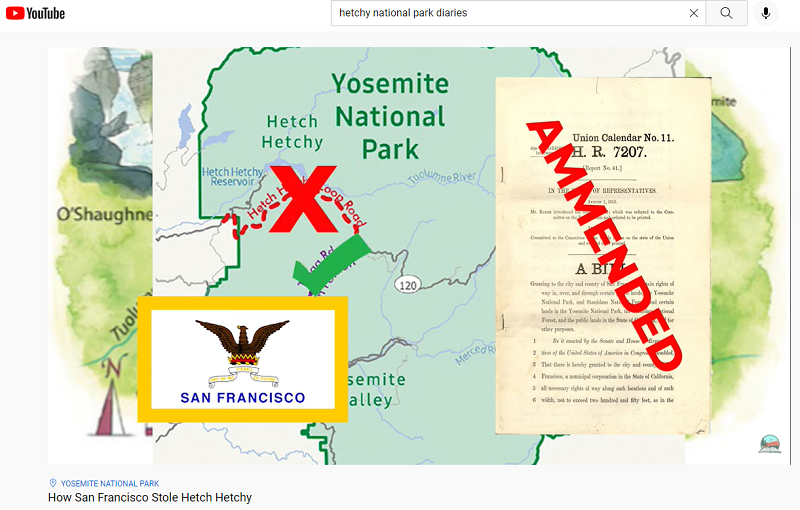
by Spreck | Feb 20, 2022 | Uncategorized
Last week, National Park Diaries published “How San Francisco Stole Hetch Hetchy” on YouTube. The story may be known to most of us, but author/historian Cameron Sabin provides several interesting perspectives, including how the progressive and conservation movements coincided at the beginning of the 20th century just at the 1906 earthquake and fire devastated San Francisco.

“How San Francisco Stole Hetch Hetchy” is the latest product from National Park Diaries – all available on YouTube.
Whether it is fair to say that San Francisco “stole” Hetch Hetchy is open to debate. The City did convince Congress to pass and President Wilson to sign the Raker Act, permitting Hetch Hetchy to be dammed and flooded. So, in a sense, saying San Francisco “stole” Hetch Hetchy is unwarranted hyperbole.
On the other hand, ignoring proverbial warnings about not watching how law or sausage is made, there is a lot not to like about the way the Raker Act was passed.
Let’s first note that a deal was made for Woodrow Wilson to appoint Franklin Lane, San Francisco’s former City Attorney, as his Secretary of Interior. Also, while Interior had directed the Army Board of Engineers to review the need for the dam, the Board did not have resources of their own to investigate and relied wholly on San Francisco’s Freeman Report. And it is worth pointing out that San Francisco Examiner Publisher William Randolph Hearst was successfully sued for libel by engineer Taggart Aston, after Aston had claimed other water projects would be superior (the ruling in the libel case came three years after the Raker Act was passed). Finally, as our Keeping Promises report explains, San Francisco’s commitments for visitor access and recreation in the Hetch Hetchy have never been realized.
While history can be intriguing, Restore Hetch Hetchy is more interested in the future. San Francisco and its Bay Area customers surely need and deserve a reliable water supply. And we all deserve Hetch Hetchy to be restored and Yosemite made whole. Our campaign is dedicated to accomplishing both these things.
by Spreck | Feb 13, 2022 | Uncategorized

Don Pedro Reservoir, downstream on the Tuolumne River, holds 6 times as much water as Hetch Hetchy Reservoir. Don Pedro is operated by the Turlock and Modesto Irrigation Districts, but 1/3 of its volume is dedicated to a water supply bank for San Francisco.
Restore Hetch Hetchy is not anti-dam. Dams are essential, especially in places like California where precipitation is seasonal and the threat of multi-year drought is omnipresent. But in many cases, the environmental and recreational benefits of a river valley outweigh any water supply or hydropower benefits a dam might provide – especially when other water supply and power options are available.
The O’Shaughnessy Dam, creating the reservoir that has inundated Hetch Hetchy Valley is arguably the most egregiously inappropriate dam in the United States (the Glen Canyon crowd might disagree.)
Note that Hetch Hetchy Reservoir accounts for only about 1/8 of the surface storage on the Tuolumne River. Re-operating other reservoirs (Don Pedro, Cherry and Eleanor), along with investment in groundwater banking in Stanislaus County could keep all communities whole with respect to water supply. Barriers to restoration include cooperation (San Francisco has tenuous relations with farmers in the area and their representatives at the Turlock and Modesto Irrigation Districts), emotion (collectively, San Francisco seems to feel entitled) and money (hopefully the easy part when we slice this Gordian knot).
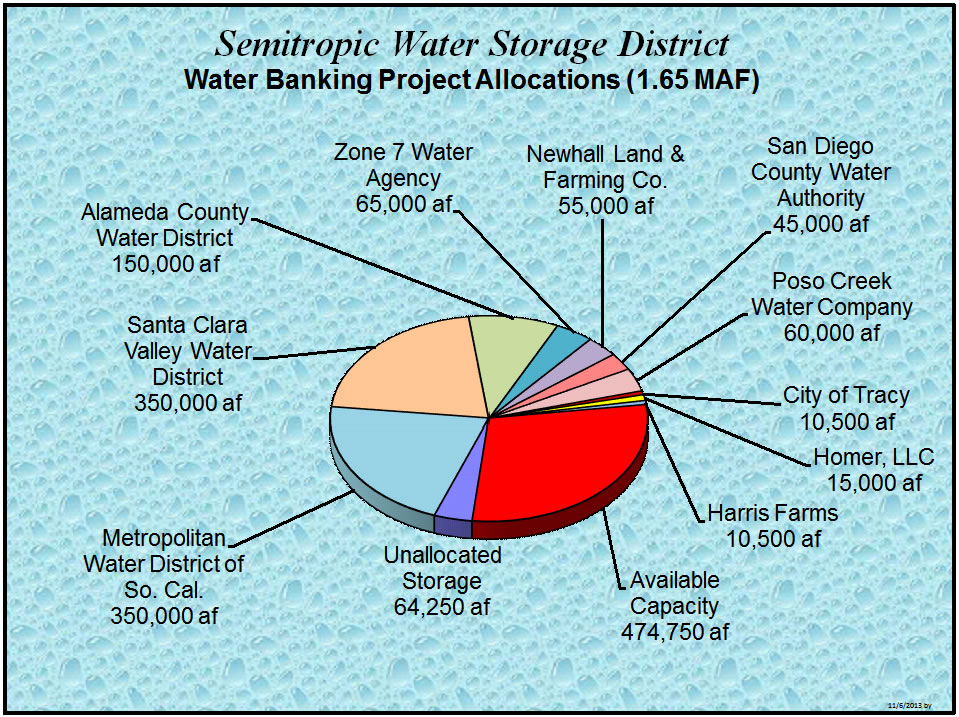
Semitropic’s total storage of 1,650,000 acre-feet is more than 4 times the size of Hetch Hetchy Reservoir.
California’s Sustainable Groundwater Management Act (2014) is critical legislation, especially for Central Valley communities, that will inflict significant short term pain but keep farming viable for centuries to come. While the Act does too little to encourage investments from remote cities, the success of places like the Semitropic Water Storage District can and should be copied in many area throughout the state.
The Modesto Bee just posted a nice Editorial Opinion, titled Forget new dams. A healthy aquifer is better for family farms and the environment. In conclusion, author Daniel Maner queries, “The next time you hear that our water problems can be solved by building more dams, ask yourself: Wouldn’t it be cheaper and less disruptive to the environment if we took stronger steps to prevent our aquifers from being drained, and use excess water to refill them instead of putting it in a new dam?
Maner is correct. In almost all cases, groundwater development is cheaper that building new dams. This is especially true because, as we explain in Hetch Hetchy and California Water Supply, Updated August 2018), “most of California’s major rivers are either already dammed, protected by law, or too remote to be economically developed.” Indeed, the vast majority of water supply development over the past several decades has been below, not above, ground.
Still, some additional reservoir development in California may make sense. We are intrigued, in fact by San Francisco’s proposal to “someday” enlarge Calaveras Reservoir by an amount almost equal to the size of Hetch Hetchy Reservoir. And Los Vaqueros Reservoir in Contra Costa County has been enlarged once, with little opposition, and may be enlarged again.
The driving force for restoring Hetch Hetchy is returning the valley to its natural splendor and making Yosemite National Park whole again. Improving water system management to make it happen will be icing on the cake.
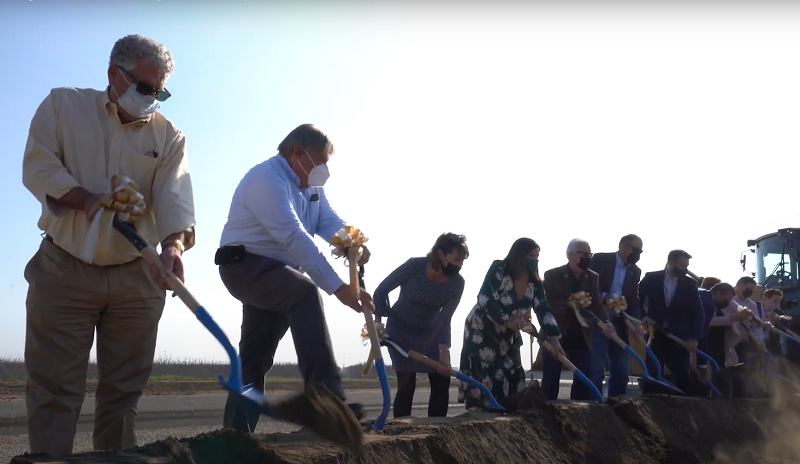
by Spreck | Jan 29, 2022 | Uncategorized
Restoring Hetch Hetchy means being serious about water system improvements for San Francisco, so we pay attention to many of the higher profile projects and trends around throughout California. The $500 million project to repair the damaged Friant-Kern Canal is worth noting for several reasons.
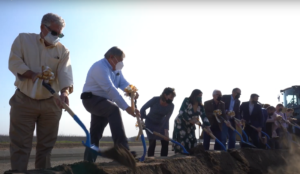 After years of seeking sufficient funds, officials ceremoniously broke ground last Tuesday. The Friant-Kern Canal is used to move water from the Friant Dam on the San Joaquin River to farms in Kern County. It has been unable to operate at full capacity for several years as the land beneath it has subsided, ironically due to groundwater pumping. The irony is magnified because, in wet years the Friant-Kern Canal is used very effectively to recharge groundwater – albeit in other areas. (For the most part, the 152 mile-long canal’s beneficiaries are not the same farmers as those whose pumping has damaged the canal – but are located further south.)
After years of seeking sufficient funds, officials ceremoniously broke ground last Tuesday. The Friant-Kern Canal is used to move water from the Friant Dam on the San Joaquin River to farms in Kern County. It has been unable to operate at full capacity for several years as the land beneath it has subsided, ironically due to groundwater pumping. The irony is magnified because, in wet years the Friant-Kern Canal is used very effectively to recharge groundwater – albeit in other areas. (For the most part, the 152 mile-long canal’s beneficiaries are not the same farmers as those whose pumping has damaged the canal – but are located further south.)
California’s 2014 Sustainable Groundwater Management Act is designed to prevent land subsidence as well as to help stabilize supplies for generations to come.
Repair of the Friant-Kern Canal has been controversial for two reasons. First, many believe that “users” should pay, rather than be subsidized (most of the cost is being picked up by the federal and state governments). Further Friant Dam and its associated canals have substantially dewatered the San Joaquin River, eliminating historic salmon runs (a restoration programs is underway but in its early stages).
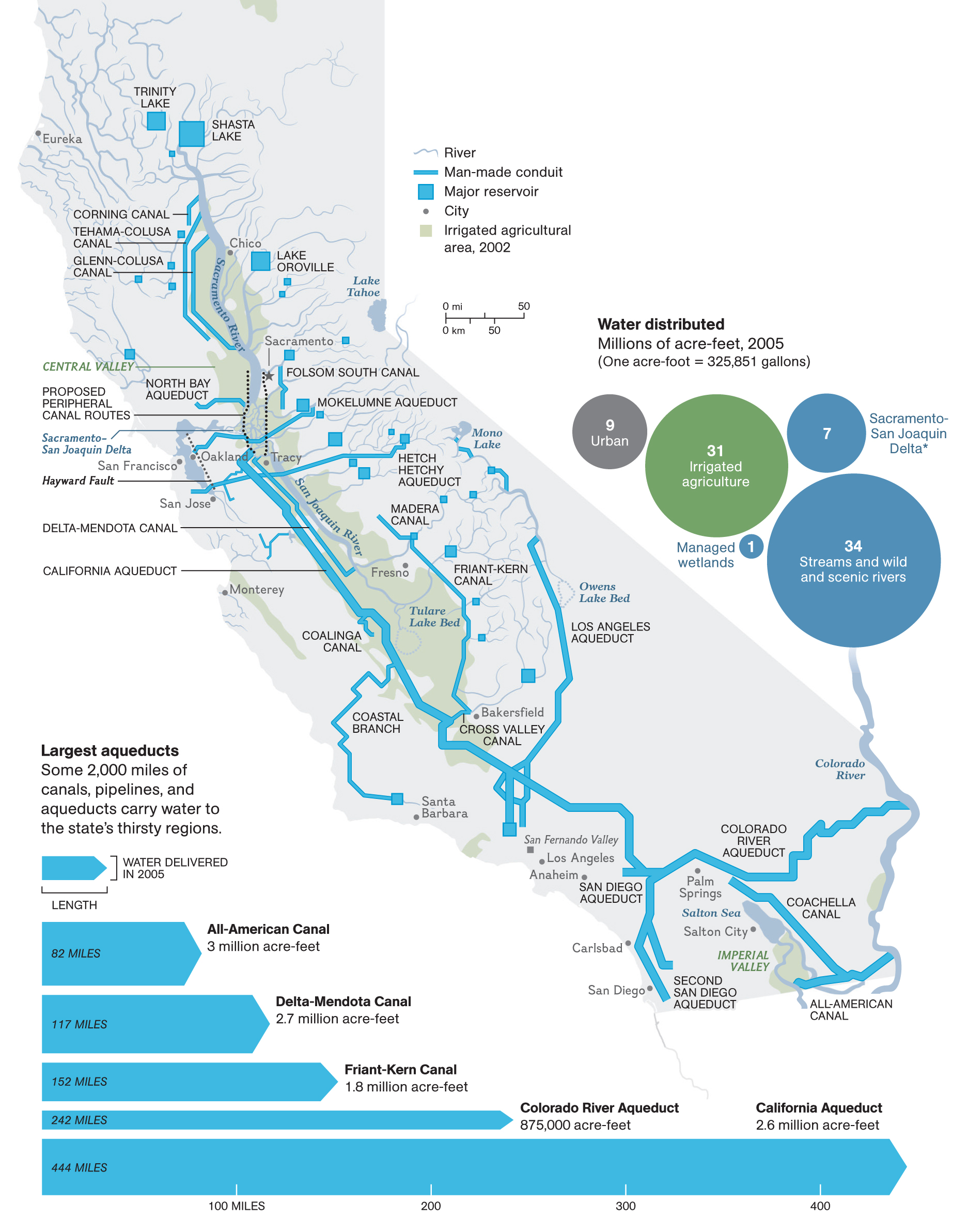
Figure 1: California’s waterworks move water from the wettest to the driest parts of the state. Click to enlarge.
California’s largest canals transport water from north to south (see Figure 1, and click to expand). Friant-Kern is a major canal, part of the Federal Central Valley Project, but is tucked away in the southeast part of the Central Valley so it is seen by few. Any motorist who has traveled Highway 5 between the Bay Area and Los Angeles, however, is familiar with the California Aqueduct and the Delta-Mendota Canal, operated by the State and Federal governments.
The largest canals moving water east to west are the All-American Canal and Colorado River Aqueduct which transport Colorado River supplies to farms in the Imperial Valley and to cities in southern California. Up north, smaller facilities which move water east to west include the Mokelumne River Aqueduct (supplying Oakland and other East Bay cities) and the Hetch Hetchy Aqueduct (bringing Tuolumne River to San Francisco and its customers in San Mateo, Santa Clara and Alameda Counties).
San Francisco’s Hetch Hetchy Aqueduct for transporting its Tuolumne River water is actually a series of tunnels and pipelines and, like Friant-Kern, has required substantial upgrades in recent years. The City is planning a 5 year, $140 million project to repair its Mountain Tunnel in the Sierra foothills. In 2015, San Francisco completed construction of a redundant Irvington Tunnel (from Sunol to Fremont, see below) to prevent an extended outage that might be caused by earthquake activity on the Hayward fault. Restore Hetch Hetchy enthusiastically supported the Irvington project amid some controversy and encouraged others to do so – we do not begrudge San Francisco its use of Tuolumne River water; we only insist that they do not store it in Yosemite National Park.

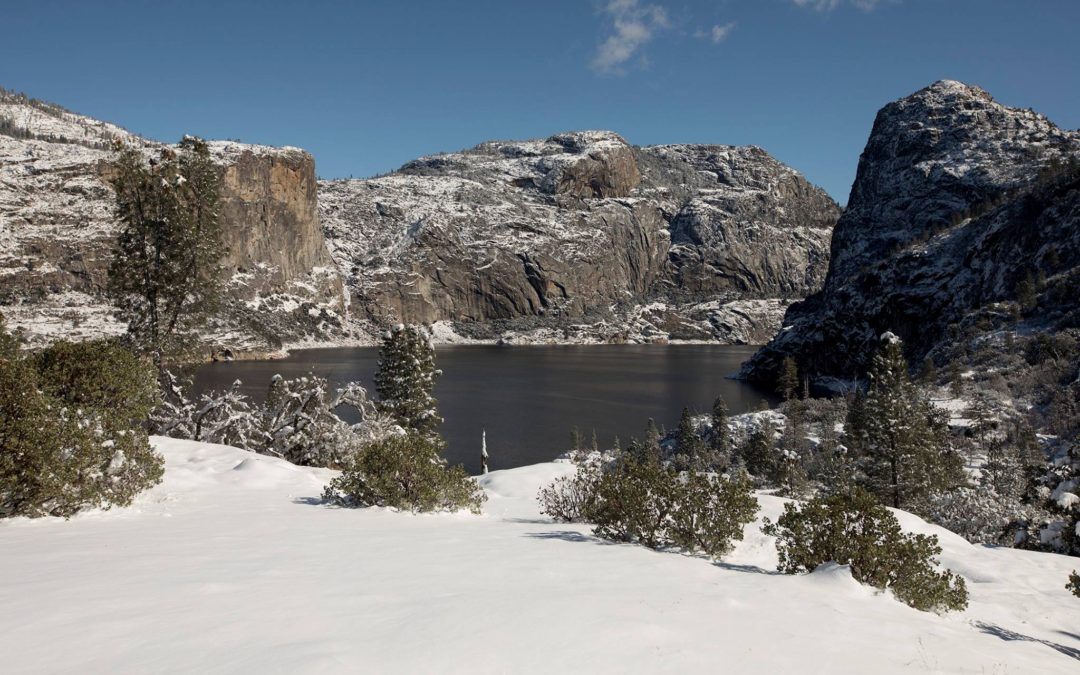
by Spreck | Dec 30, 2021 | Uncategorized
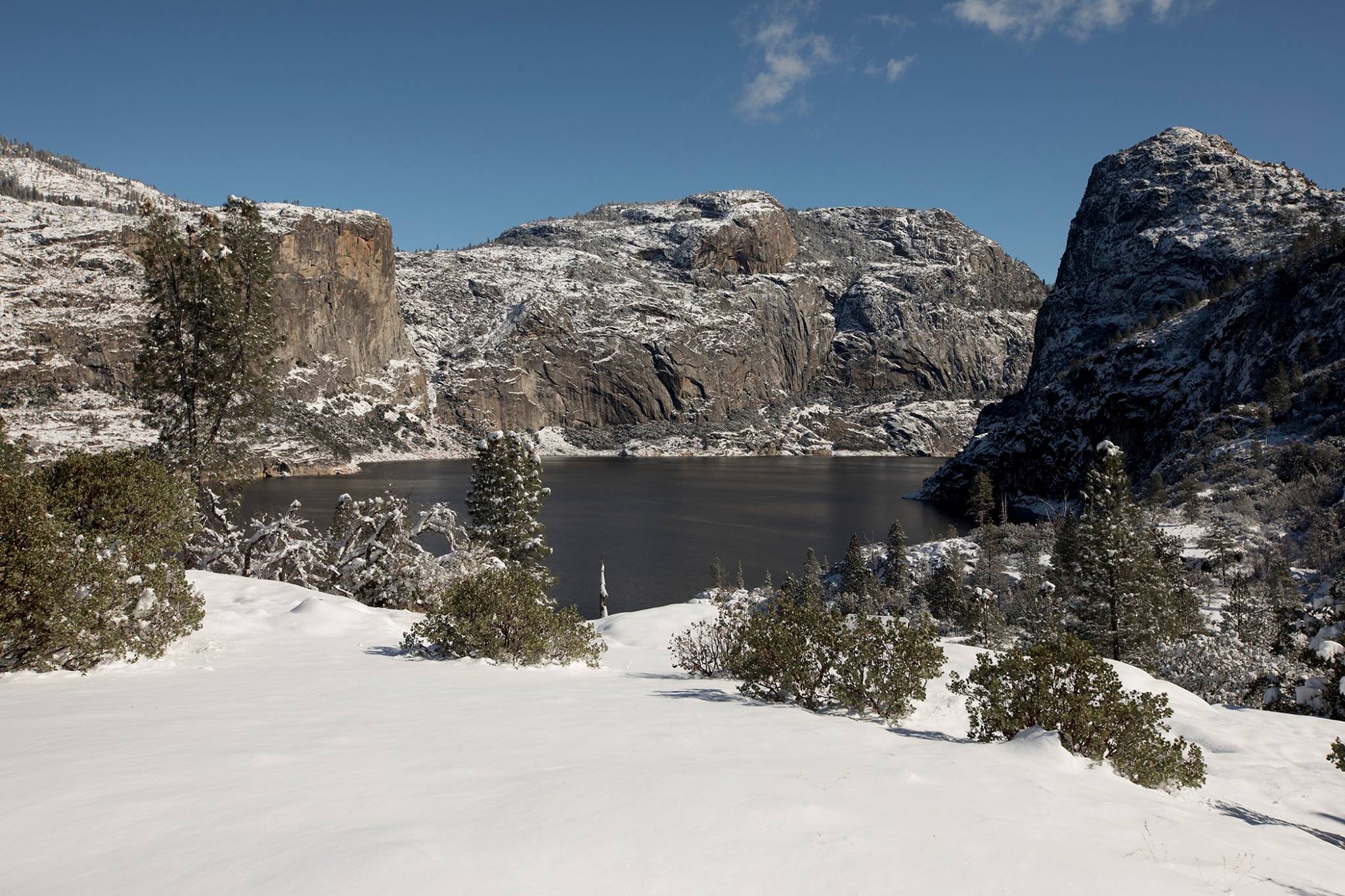
Melting snow on the north rim at Hetch Hetchy can create a dozen simultaneous waterfalls – a site to behold.
After two very dry years, it’s especially nice to enter 2022 with one of the wettest autumns ever.
How wet has it really been? It’s too soon to be definitive about how much snow has fallen as the State of California has not yet completed its first snow survey – an operation that requires measuring both the depth and density of snow at standardized locations.
Rainfall, however, is easier to measure. Throughout the Central Valley we have already surpassed last year’s total and, in the north, we are on pace for the wettest year in more than a century. California’s Data Exchange Center shows cumulative rainfall totals on a daily basis for the Northern Sierra, San Joaquin and Tulare Basin, and compares them to values in prior years.
From a scientific perspective, our case for restoring Hetch Hetchy is not affected by drought. After all, we are advocating that San Francisco invest in system improvements that would fully replace, at a minimum, the water supply function of Hetch Hetchy Reservoir (storing Tuolumne River supplies in groundwater basins in Stanislaus County or an enlarged Calaveras Reservoir in Alameda County, or recycling wastewater in the Bay Area, are all viable options).
Adequate water supply is such an emotional issue, however, that it is much easier to talk to people, especially elected officials, when drought is not on the front page. So we are happy about the wet weather – both because we need the rain AND because it makes it easier to advocate for restoration.
We are grateful to all our supporters and thank all who have already made year-end contributions. If you haven’t contributed in 2021 but would like to, send a check (dated today) to Restore Hetch Hetchy, 3286 Adeline St. Suite 8, Berkeley, California 94703, or contribute online.
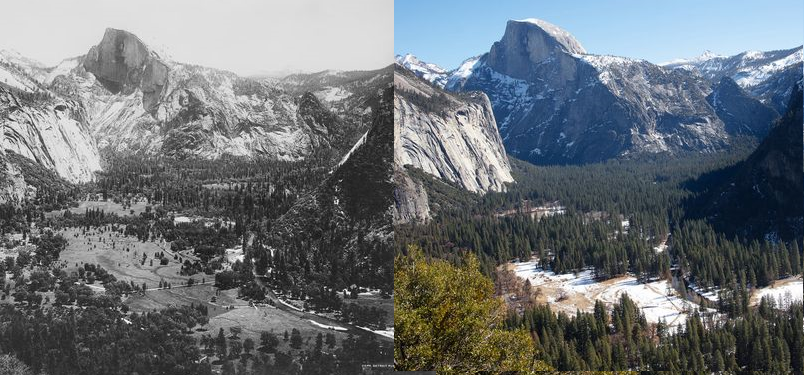
by Spreck | Dec 28, 2021 | Uncategorized
There will be many benefits to realizing our vision of returning Hetch Hetchy Valley in Yosemite National Park to its original splendor, without the traffic and congestion that too often diminishes the visitor experience in Yosemite Valley.
There are only three days left in 2021 to make a tax-deductible contribution to Restore Hetch Hetchy. Please help by sending a check to Restore Hetch Hetchy, 3286 Adeline St. Suite 8, Berkeley, California 94703, or contributing online.

Photos from 1913 and 2021 show how fire suppression in Yosemite Valley has allowed coniferous forests to overtake meadow habitat, interrupting the natural balance. We can do a better job when we restore Hetch Hetchy.
While it is essential to provide camping and lodging, our plan is to locate the vast majority of infrastructure adjacent to, but not within, Hetch Hetchy Valley. This plan will allow wildlife and the Tuolumne River to run free, and the meadows to flourish. Visitors will visit, but not overrun the valley.
Minimizing infrastructure within the valley will make it far easier to manage Hetch Hetchy during wildfires. Without structures to protect, occasional small fires can be allowed to burn – maintaining the natural balance between forest and meadow. (The photos above show how the balance between forest and meadow has changed over time in Yosemite Valley. In 1913, Yosemite Valley included more expansive meadows than it does today. Due in large part to a century of fire suppression, much of Yosemite Valley is now dominated by young conifers. We all love trees, but it is important to achieve the right balance between saplings, mature trees and open meadows.)
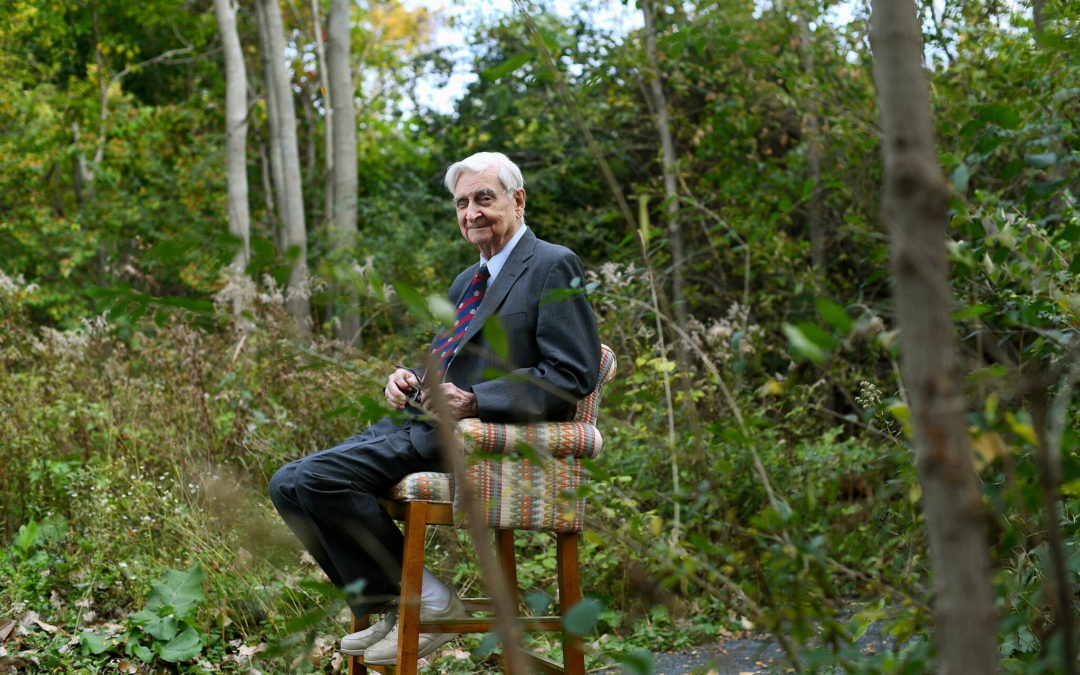
by Spreck | Dec 27, 2021 | Uncategorized
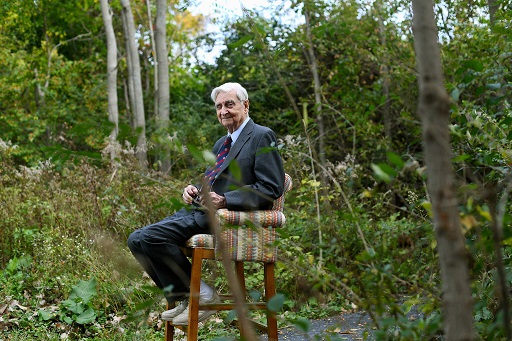 Harvard biologist Edward Osborne Wilson, sometimes described as the “father of biodiversity”, passed away yesterday. He will be missed.
Harvard biologist Edward Osborne Wilson, sometimes described as the “father of biodiversity”, passed away yesterday. He will be missed.
Wilson was a groundbreaking biologist, initially recognized for his study of ants. He authored 30 books and 430 academic papers, held 40 honorary doctorates, and was an engaging speaker. Wilson became an advocate for restoration of vast landscapes in an effort to protect the earth for future generations, opining on the value of “reweaving the wondrous diversity of life that still survives around us.”
We arranged to meet Wilson in 2016, when he came to Berkeley for a conference on the 100th anniversary of the National Park Service. He asked when “that damn dam was coming out?”. We asked if he might help. Wilson did not specifically decline but, like many academics, did not seem willing to engage in a political effort like ours.
E.O. Wilson also served as the inspiration for EDF’s Paradise Regained: SOLUTIONS FOR RESTORING YOSEMITE’S HETCH HETCHY VALLEY. EDF, like Restore Hetch Hetchy, is staunchly nonpartisan, and recruited two former California Resource Secretaries, Republican Doug Wheeler and Democrat Huey Johnson, to draft a foreword for the report. They did do, drawing on Wilson for inspiration – see below.
Foreword
More than a decade ago, the renowned Harvard biologist, E.O.Wilson, spoke of the need of repairing, where possible, the environmental damage which is an unfortunate legacy of heedless development in sensitive areas. In his seminal book, The Diversity of Life, Wilson urges that we now “go beyond mere salvage to begin the restoration of natural environments, in order to enlarge wild populations and stanch the hemorrhaging of biological wealth.”
To a remarkable extent, 21st-century Americans have taken Wilson’s updated definition of the public trust to heart, and are everywhere engaged in restoration projects small and large. Some are audacious indeed, striving to reweave and restore entire habitats on a scale as large as Florida’s Everglades, the Chesapeake Bay, and San Francisco’s Bay- Delta Estuary; others are as small as the watersheds of local, but nonetheless productive, creeks and tributaries. These projects result from the growing conviction that we have the capability, if not the obligation, to make amends for past mistakes, using newfound scientific knowledge and advanced technologies.
We think of Wilson’s words as we read this report on the development of feasible alternatives to the water supply and hydroelectricity, which are currently provided by the O’Shaughnessy Dam on the Tuolumne River in the Hetch Hetchy Valley. Almost from the time of its construction early in the last century, visionaries have argued for the restoration of Hetch Hetchy to its splendid natural condition. Perhaps they can be excused for having given short shrift to the social and economic consequences of so bold a vision: millions of northern Californians have come to depend on the water and power of the Hetch Hetchy system. Whatever one’s opinion of the merits of the original decision or of federal and state water policies as they evolved over the last century, however, no plan for the restoration of the Hetch Hetchy Valley, no matter how felicitous, can be considered without addressing this dependency on the current system.
Indeed, restoration advocates bear the burden of proving that alternatives can be made to work. In accepting this challenge, Environmental Defense, with the help of three distinguished consulting firms, has produced an extraordinarily thorough and thought-provoking assessment. As veterans of many an environmental controversy, we know that a lengthy dialog must precede any decision as momentous as the proposal to restore Hetch Hetchy and that the legitimate concerns of all stakeholders must be addressed. We welcome the publication of this report as an essential element of that dialog, coming at a time when the San Francisco Public Utilities Commission must make costly long term decisions about upgrades to its Hetch Hetchy infrastructure. It is also time, as E.O.Wilson suggests, to begin “reweaving the wondrous diversity of life that still survives around us.”
Douglas P. Wheeler and Huey D. Johnson both served as Secretary for Resources, State of California, in 1991–99 and 1978–82, respectively. Doug Wheeler presently chairs the National Park System Advisory Board and was formerly Executive Director of the Sierra Club and co-founder and President of American Farmland Trust. Huey Johnson was formerly the Western Regional Director of The Nature Conservancy and founder and President of the Trust for Public Land. He presently leads the Resource Renewal Institute.






 After years of seeking sufficient funds,
After years of seeking sufficient funds, 





 Harvard biologist
Harvard biologist